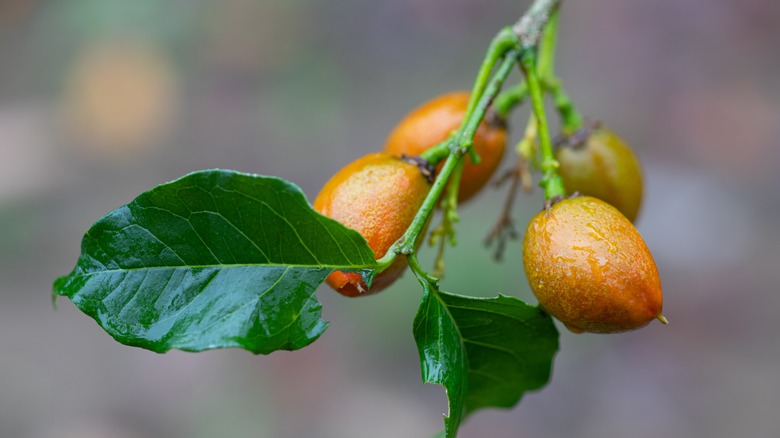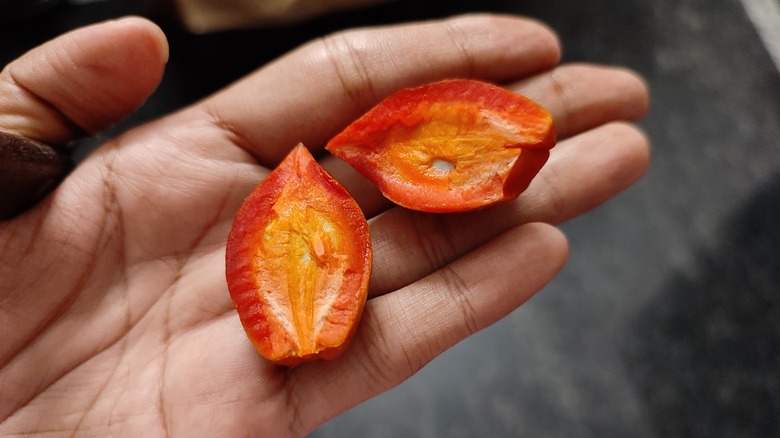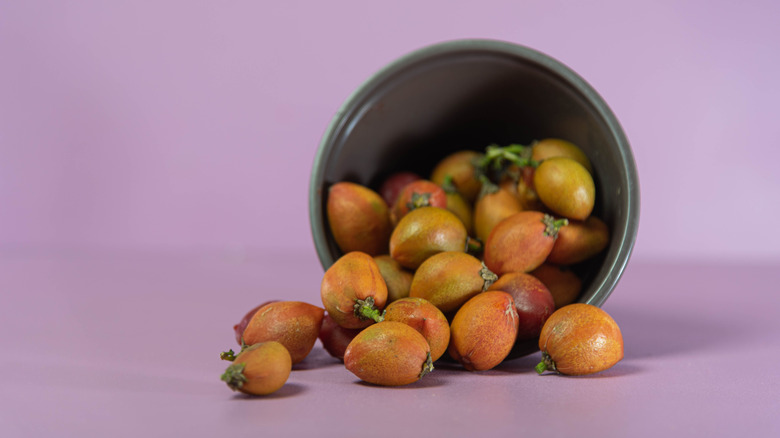The Tomato-Esque Fruit That Tastes Like PB&J
The world of fruit has many hidden surprises: There are fruits that look like white strawberries but taste like pineapples and those that look like melons but smell like fresh bread when baked (yes — it's breadfruit). There are plump grapes that taste like cotton candy, savory mangoes that remind one of French onion soup, and others yet that taste like sweet egg custard. But all that pales in comparison to one small fruit. It looks like a grape tomato but tastes like peanut butter with hints of jelly, and it's appropriately called the peanut butter fruit or, Monk's Plum.
Part of the Malpighiaceae family of plants, the peanut butter fruit (also known as Bunchosia argentea or Bunchosia armeniaca) goes from orange to red in color as it ripens and is no larger than a big olive. Its unique flavor aside, the peanut butter fruit is also linked to several health benefits (per Texas Real Food). It may lower cholesterol, reduce the risk of prostate cancer, and regulate heart health. In fact, while it looks like a small tomato, peanut butter fruits have 10 times the lycopene present in tomatoes — a powerful antioxidant that comes with myriad health benefits of its own. So why is it that you've probably never heard of this fruit before? It's because peanut butter fruits are very fragile and don't fare well shipped across the world — which is why you'll rarely find them stocked at the corner shop near your house.
What exactly does the peanut butter fruit taste like?
Although they may look like oblong grape tomatoes hanging off a vine, peanut butter fruits are nothing like those sour and acidic fruits. On the contrary, the peanut butter fruit both smells and tastes like its namesake. In fact, even the thick flesh that surrounds the lone seed inside the fruit has a dense and sticky texture that is reminiscent of the creamy consistency of smooth peanut butter!
While the overlying flavor of the fruit is that of peanut butter, that's not the only thing that the fruit tastes like. Peanut butter fruits also have some sweetness to them, with notes of sweet potatoes, berries, and dried figs. The fruity and peanut butter-like flavors — coupled with its thick and jammy texture — together give the fruit the sweet and nutty taste of a classic peanut butter and jelly sandwich.
The fruits that are more orangish in color have a firmer texture and tend to taste less like jelly, more like peanut butter, and are generally a tad bland whereas the more ripened and red-colored fruits have the most obvious PB-and-J flavors. As a bonus, the fruit is also an excellent way for those allergic to peanuts to get a taste of a PB-and-J sandwich in an entirely legume-free form.
Where to buy and how to eat peanut butter fruit
Native to the South American Andes – which includes Chile, Venezuela, Colombia, Argentina, Peru, Bolivia, and Ecuador — peanut butter fruits are usually in season in the months of summer and fall. Although the tropical fruit is rarely exported commercially out of this region thanks to its perishability, peanut butter fruits are also grown in the sunny and warm weather of Brazil, Australia, and parts of the U.S. — mainly Hawaii, California, and Florida.
The fruit's skin and pulp are both edible and can be eaten raw — the best way to enjoy its peanut butter and jelly flavor. The pulp of the fruit can also be mixed into milkshakes and desserts like cakes. If you do manage to snag a bunch of ripe peanut butter fruits, make sure to eat them as quickly as you can because they don't have a particularly long shelf life. Alternatively, you can refrigerate whole fruits to extend their lifespan by a few days or scoop out the seeds and freeze the remaining fruit for even longer. Another way to extend the fruit's shelf life is to turn it into a jam, jelly, or preserve — so that the next time you want a peanut butter sandwich, you'd only have to slather this fruit spread between two slices of bread.



